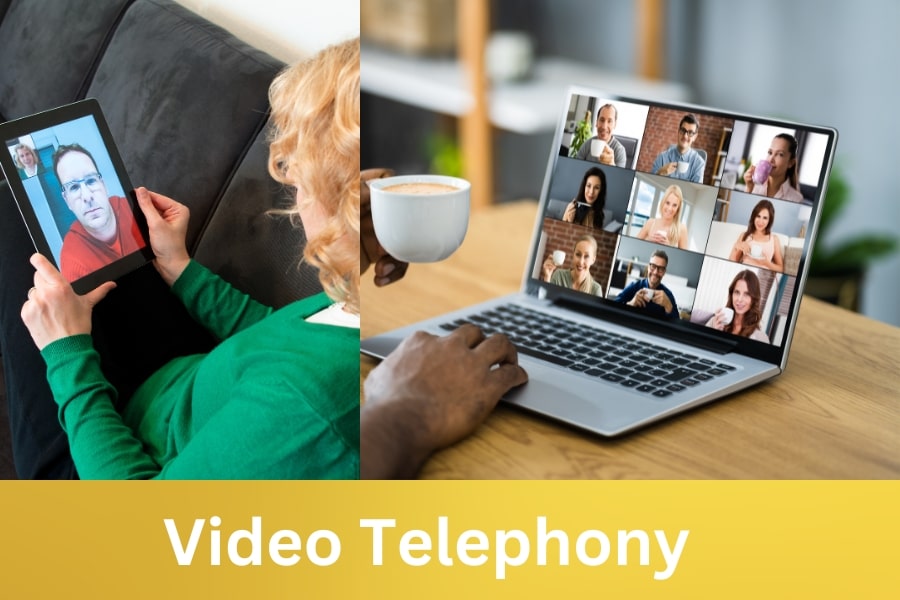What Is Video Telephony and Why it’s Important for Businesses in 2024

In a world where distance used to mean disconnection, technology has woven a new thread of togetherness through video telephony. Imagine talking with faraway family and friends as if they’re right beside you. That’s the magic of video calls – where voices and smiles come alive on screens.
From chatty catch-ups to serious work meetings, video telephony sweeps us into its visual embrace. It’s like teleporting without leaving your room!
No need for big words, just a camera, a microphone, and the power of the internet. You talk, they see; you listen, they nod. Quick, simple, and personal.
But it’s not just about chats. Businesses hold virtual handshakes, doctors heal through screens, and schools transform into pixelated classrooms.
In this blog post, we’ll uncover the tapestry of video telephony, revealing how it ties families, careers, education, and even emergencies into a single digital conversation. Ready to dive into the world of virtual face-to-face? Let’s get started.
Video Telephony and Video Conferencing. THEY ARE NOT THE SAME!
Find the Contents
Video telephony and video conferencing may seem like close cousins, but they play slightly different roles in the digital realm. Think of them as two sides of the same communication coin.
Video Telephony: Video telephony is like a one-on-one chat with a friend, just with screens in between. It’s about making personal connections across distances. Imagine your best friend’s face lighting up on your phone as you swap stories, all while seeing each other’s expressions.
Videotelephony dances in the world of intimacy, helping families stay close even when oceans are apart. So, the next time you see Grandma’s smile on your tablet, that’s video telephony at play.
Video Conferencing: Now, let’s zoom out a bit to video conferencing. This is where multiple folks gather on the digital stage. It’s like a virtual meeting room where colleagues discuss projects, bosses share strategies, and teams brainstorm, all in real time, just like a physical meeting but without travel.
With video conferencing, you can be part of the action, no matter if you’re in an office or on a hammock by the beach.
So, while video telephony is your personal hotline to loved ones, video conferencing opens the door to collaborative discussions on a larger scale. Two flavors of the same tech magic, connecting people in ways that once seemed straight out of science fiction.
What You Need for Effective Video Telephony:
Entering the realm of video telephony doesn’t demand a spaceship-like setup. In fact, you probably have most of what you need already.
- Device: Any modern smartphone, tablet, laptop, or desktop computer with a camera can be your video telephony gateway. It’s like having a window to the world in your pocket or on your desk.
- Camera: This is your digital eye. Most devices come equipped with built-in cameras, but if you’re looking for even crisper visuals, external webcams are a popular add-on.
- Microphone: Good communication requires good sound. Built-in microphones do the trick, but an external one can enhance your voice clarity, making sure your laughter and stories travel clearly.
- Internet Connection: The internet is the virtual highway that carries your video and sound signals. A stable and reasonably fast connection keeps the conversation smooth.
- App or Software: Video telephony apps like Zoom, Skype, Microsoft Teams, and FaceTime are your magic carpets. Download and install your chosen app, create an account, and you’re set to dial.
- Optional Accessories: Headphones can help isolate sound, while a pair of earbuds with a microphone can provide privacy and clearer sound in noisy environments.
Whether it’s catching up with pals or sharing family stories, the gear for video telephony is often just a click away. So, grab your device, put on your virtual traveling shoes, and connect with your world, near and far.
How to Do Video Telephony: It Way Easy
Ready to embark on your video telephony adventure? Follow these simple steps to dive into the world of virtual face-to-face conversations:
- Choose Your Platform: Select a video telephony platform that suits your needs. Popular choices include Zoom, Skype, Microsoft Teams, FaceTime, and Google Meet. Download and install the app on your device.
- Set Up an Account: Register for an account if required. Follow the prompts to create a username and password, and complete any necessary profile information.
- Test Your Equipment: Ensure your camera, microphone, and internet connection are working properly. Check lighting and background to ensure a clear and presentable view.
- Initiate a Call:
- Open the video telephony app.
- Sign in to your account.
- Choose a contact from your list or enter their username/number/email.
- Select “Start Call” or a similar option to initiate the call.
- Receive a Call:
- If someone calls you, you’ll receive a notification.
- Accept the call to start the video conversation.
- During the Call:
- Smile and maintain eye contact with the camera.
- Speak clearly and adjust your volume if needed.
- Use headphones or earbuds for better sound quality, especially in noisy environments.
- Mute your microphone when not speaking to minimize background noise.
- Use video controls to adjust camera settings, switch between front and rear cameras, and turn video on/off if needed.
- End the Call:
- When the conversation is over, say your goodbyes.
- Select “End Call” or a similar option to disconnect.
- Etiquette Tips:
- Be punctual, just like in-person meetings.
- Look into the camera when speaking for a natural eye contact effect.
- Dress appropriately for the context of the call.
- Choose a quiet and well-lit location.
- Minimize distractions and maintain focus on the conversation.
- Practice Makes Perfect: Don’t worry if you’re new to video telephony. With a bit of practice, you’ll become a pro at navigating the virtual landscape and connecting with others seamlessly
You May Also Like: Best Lightweight Budget Laptops For Travel
How Video Telephony is Important for Businesses:
In the modern business landscape, video telephony isn’t just a luxury – it’s a strategic necessity that’s transforming how companies operate and interact. Here’s why video telephony is a game-changer for businesses:
- Global Connectivity: Video telephony erases geographic boundaries, allowing teams, clients, and partners to connect from different corners of the world. International collaborations are smoother than ever.
- Real-Time Collaboration: Video calls enable real-time discussions, document sharing, and brainstorming sessions, replicating the dynamics of in-person meetings without the travel hassle.
- Remote Work: As remote work becomes mainstream, video telephony bridges the gap between remote employees. It fosters team cohesion and ensures everyone stays on the same page.
- Reduced Costs: Video calls eliminate travel expenses, saving companies money on flights, accommodations, and other logistical costs associated with face-to-face meetings.
- Enhanced Communication: Non-verbal cues like facial expressions and gestures are crucial for effective communication. Video calls provide these cues, ensuring messages are accurately conveyed.
- Client Relations: Video telephony offers a personal touch in client interactions. From product demos to project updates, face-to-face video calls build stronger client relationships.
- Recruitment and Onboarding: Businesses use video interviews to efficiently evaluate candidates and make informed hiring decisions. Video onboarding ensures new employees receive a warm welcome, even from a distance.
- Training and Workshops: Conducting training sessions and workshops via video telephony allows companies to train employees regardless of their location, boosting professional development.
- Crisis Management: During emergencies, video telephony helps companies swiftly communicate with stakeholders, make critical decisions, and maintain business continuity.
- Flexible Communication: Video telephony offers flexible communication options, from one-on-one calls to large-scale webinars, catering to various business needs.
- Competitive Edge: Embracing video telephony showcases a company’s adaptability and tech-savviness, giving it a competitive edge in a digitally evolving marketplace.
- Environmental Impact: Reduced travel due to video telephony contributes to lower carbon footprints, aligning with sustainability goals.
In the corporate world, video telephony isn’t just about calls; it’s about fostering innovation, collaboration, and efficiency. As businesses continue to embrace digital transformation, video telephony stands at the forefront, enabling dynamic connections that drive success.
| Using Video Telephony in Your Business | Not Using Video Telephony |
|---|---|
| Global Reach: Connect with clients, partners, and teams worldwide in real-time. | Limited to local communication, missing global opportunities. |
| Cost Savings: Reduce travel expenses and associated costs for meetings. | Incur higher expenses for travel, accommodations, and logistics. |
| Efficient Collaboration: Conduct remote meetings, brainstorming, and training sessions. | Depend on traditional in-person meetings, potentially causing delays. |
| Flexible Work Environment: Facilitate remote work and provide work-life balance. | Restrict employees to office-based work, potentially affecting morale. |
| Enhanced Communication: Maintain visual and non-verbal cues, improving understanding. | Rely solely on emails and calls, leading to potential misinterpretations. |
| Client Engagement: Offer virtual demos, product presentations, and consultations. | Miss opportunities for personal engagement and demonstrations. |
| Talent Acquisition: Conduct video interviews, expanding the candidate pool. | Limit hiring options to local candidates due to in-person interviews. |
| Business Continuity: Ensure operations during emergencies with remote communication. | Face challenges in maintaining communication during crises. |
| Professional Development: Provide remote training and workshops for skill enhancement. | Miss out on virtual learning opportunities for employees. |
| Competitive Edge: Showcase adaptability, technology adoption, and innovation. | Lag behind competitors embracing modern communication methods. |
Frequently Asked Questions (FAQs):
-
What is video telephony, and how does it work?
Videotelephony is a technology that enables real-time audio and visual communication between individuals or groups using cameras, microphones, and internet connectivity.
It allows people to see and hear each other as if they were in the same place, even when they are physically apart. -
What are the benefits of using video telephony in business?
Videotelephony offers numerous benefits for businesses, including global connectivity, cost savings from reduced travel, real-time collaboration, flexible work options, enhanced communication with clients, efficient talent acquisition, and improved crisis management capabilities.
-
Can video telephony be used for educational purposes?
Yes, video telephony plays a crucial role in education. It enables online classes, virtual classrooms, and remote learning, and facilitates interactions between teachers and students regardless of their physical location.
-
Is video telephony secure for sensitive conversations?
Most reputable video telephony platforms use encryption and security measures to protect conversations.
However, it’s important to choose trusted platforms and ensure your network connection is secure, especially for sensitive business or personal discussions. -
How can video telephony benefit remote workers and freelancers?
Videotelephony is essential for remote workers and freelancers. It helps them stay connected with colleagues, attend virtual meetings, collaborate on projects, and maintain a sense of belonging to the team, even from a distance.
Last Words on Video Telephony
As we’ve explored the diverse applications of video telephony, it’s clear that its impact knows no bounds.
It empowers remote work, revolutionizes education, transforms healthcare delivery, and enhances customer relationships. With every call, we’re transported to different worlds, united by the shared experience of seeing smiles, hearing laughter, and sharing moments.
But this is just the beginning. As technology evolves, video telephony will continue to evolve with it. Augmented reality and virtual reality may step onto the stage, blurring the lines between the digital and physical worlds even further.
So, whether you’re catching up with a friend, closing a business deal, or attending a virtual class, remember the power that resides in those pixels on your screen.
Videotelephony isn’t just about calls – it’s about building connections, fostering understanding, and embracing a future where distance is no longer a barrier to being close. In this digital age, the world truly is at your fingertips, waiting to be explored through the lens of video telephony



One Comment